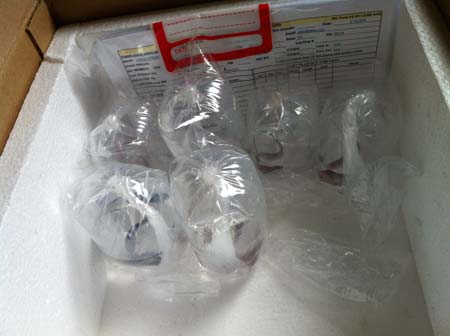Advice on Entry Forms and Shipping
The California Betta Society uses the standard IBC Show Entry Forms.
For an International show, IBC members are allowed to enter up to 50 fish entries (60 total
fish including pairs). There is no additional limit for arts and
crafts entries. Non-members can only enter 10 items total, both fish
and crafts combined.
A snapshot of an example form using the "help" for classes is provided
for guidance, and then also there's a short video by Gianne Souza on how to
both pick out the fish and fill out the form.
Other useful files are:
- Shipping Instructions
[doc] - How to ship your fish to the show
- Show entrant guide - detailed information about entering your fish in an IBC show,
sent out by the IBC Judging Board
- Standards Update Summary - Summary of all the changes to the Standards for this season,
prepared by the IBC Judging Board
- Show flyer - printable show information
Art and Craft Entries
Art and Crafty Entries use the same entry form, but they should be
shipped SEPARATELY from the fish.
Shipping Fish to a Show
There's a lot of details going into how to send a fish to a show.
Here are covered some of the very basics, and there's also some useful
videos. Everything here are only basics - ask
on the BetterBettas list or the IBC or CBS Facebook pages if you have any questions!
Basic Shipping Instructions
- You will need long plastic fish bags from a pet shop (not from the
grocery store!). Two are required for each betta going to a show, and 2 for
each betta at the end for either auctioning or to be shipped back to you.
.You will also need the following items:
- An IBC Entry Form [xls]
- A Styrofoam box inside a cardboard box used for shipping fish. This
can be obtained at local pet stores.
(Please use styrofoam as the buffer! It's light-weight, insolates well,
and doesn't become heavy and soggy if water spills on it.)
- A waterproof marker or permanent label for marking each bag.
- The IBC Judging Standards or
Class List for
classifying your bettas; and
- An extra bag to hold your entry fees, forms, return postage, and
other items you do not want to get wet.
.
- Double bag each betta and use enough water to adequately cover the
fish. Remember that water adds weight and increases the postage and the
air held in the bag is almost more important to the betta. However, you
want to make absolutely certain that the water covers the betta
completely, no matter which way the bag is tipped. See pictures
below for examples.
Knot the first
bag, leaving 2/3 air. Tie the knot very tight! Then put that bag, with the knot end down, into the
second bag. This helps to guard against leaking. Tie and knot the
second bag.
.
- Find the classification sheet or class list and classify each fish
with the appropriate number. Record the classes on the fish bag and also on
the entry form. Also record the entry form item number on the bag. If you
are in doubt as to how to classify a particular fish, mark the entry (both
places) with “class help”. The judges are on your side and understand that
some fish can pose a classification problem for the novice and experienced
hobbyist alike.
Use the remarks area for auction labels and also it's good for both show
people and yourself to try and match up your fish when they get shipped
around. Even if it's a 'help' class fish, if it's got "blue hm' on the
remarks... the people unpacking can go "oh yeah, that one! yep, he's here."
.
- Decide which bettas you might like to auction. Auction proceeds can
help pay the expenses of showing. Remember that you have no way of knowing
though, whether the fish may take a ribbon and you may be auctioning off a
winner. Mark your entry sheet and the corresponding bag to make sure that
the right fish is being auctioned.
.
- Put the bags in the Styrofoam box along with any additional cushioning
material. You might also put each bagged fish into a brown lunch bag to keep
them isolated and insulated.
.
- Weigh the box. Call the Post Office and find out the return postage
for Priority Mail and Express Mail.
.
- Put your entry form, entry fees, and return postage in a plastic bag.
Seal the box with strapping tape. NOTE: Please do NOT label the box “Live Fish” on
the outside – this can cause issues with certain shipping companies.
("Water samples" is preferred.)
.
- Mail your bettas Priority Mail (usually 2-3 days) or Express Mail
(usually overnight). It keeps the box from sitting in cold rooms for long
periods of time.
.
- Timing the mail so the box should arrive the day before fish are
supposed to be benched. In general, for a normal show where benching takes place
Friday, if using Express - mail on Wednesday morning (Express Mail) or using
Priority - mail on Tuesday morning. However, CHECK with your local
post office! Some shipments take longer to get places, and even
Express Mail can sometimes take two days if mailing from a remote location.
Check FIRST (like the week before) so you'll know.
.
- Cross your fingers and wait for the results!
Note: If you cannot find some of the items needed to ship your fish, IBC
sells plastic bags, heat packs (for shipping in the late fall or early spring),
shipping labels, and styro boxes. Check the
IBC sales site for prices and purchase information.
Pictorial Highlights:
Make sure the water covers the fish! Both when the bag is upright
and when it's on it's side (the boxes will be moved around during shipping,
and you can't always count on "this end up"). Longer-finned fish and crowntails will
need more water (for buffering) than shortfins and females. No matter
how much water you put in, make sure there's at LEAST as much air, and
preferably more. The standard ratio is 2/3 air to 1/3 water. Due to
box shipping size, sometimes people will put less than this in, but make
very very sure there's always at least as much air as water. The fish
are traveling for a long time, and they'll die if there's too much water and
not enough air. (Yes, bettas are different - that's why we love them.)
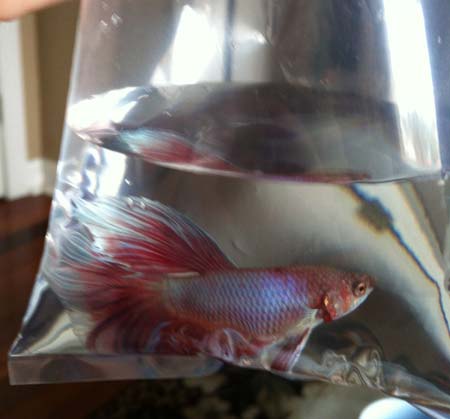
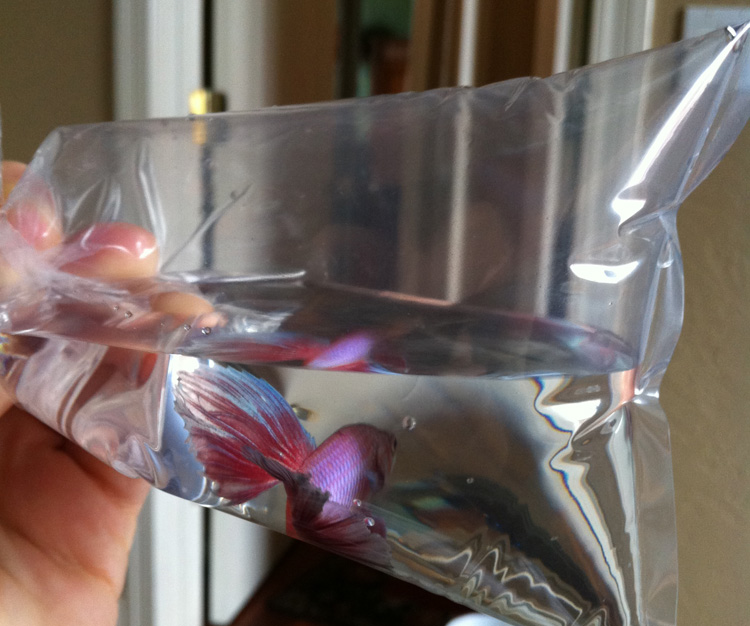
Tie the bag TIGHT!!! The main reason we use the extra long bags is
so we can get a really really good knot on the bags. Twist that
bag around until it's tighter than heck then KNOT! Pull that knot
tight! Use your teeth if you have to, but make absolutely sure that
the knots are tight and water won't leak. (Hint - make the inner
bag just slightly less than full with so the second bag can go over it
easier.) (Also, make sure the inner bag is dry before trying to put the
outer bag over it.)
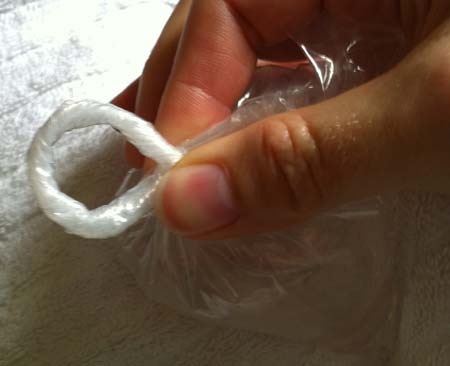
Fully bagged and double-bagged, with enough water to cover the fish, and
plenty of air to breathe. Longfinned males require more water for buffer
usually than females and shortfins. Your bags might have more water
and more air than the example pictures. These are *only* examples -
each person's shipping requirements will vary by fish and box size and
number of fish being shipped. Always, always, though have at *least*
50/50 air/water and preferred is 2/3rds air, 1/3 water.
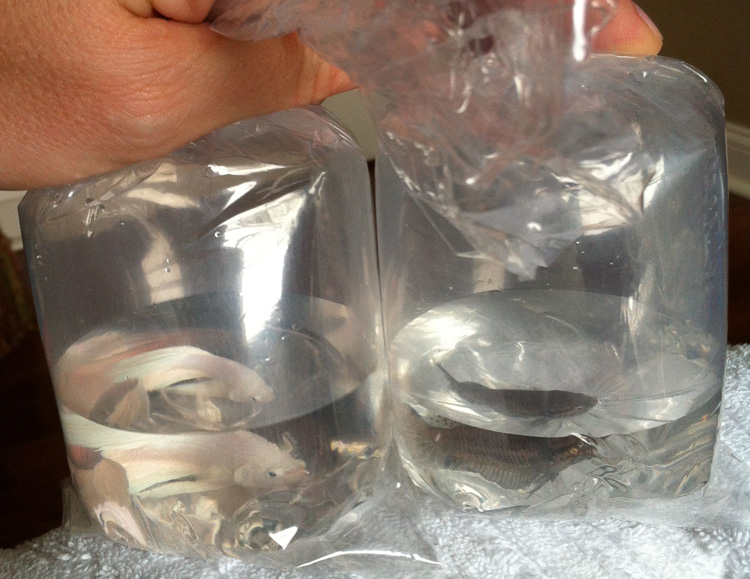
Pack the bags into the box, with the inner bag tie up (outer bag tie
down). Have your entry form and other paperwork in the box in a ziplock plastic bag in case of water leaks. When all the bags are in
the box, then put additional shipping material such as styro peanuts,
airbags, crunched up newspaper, etc, in to make sure the fish are buffered
during shipping and won't be thrown around inside it.
